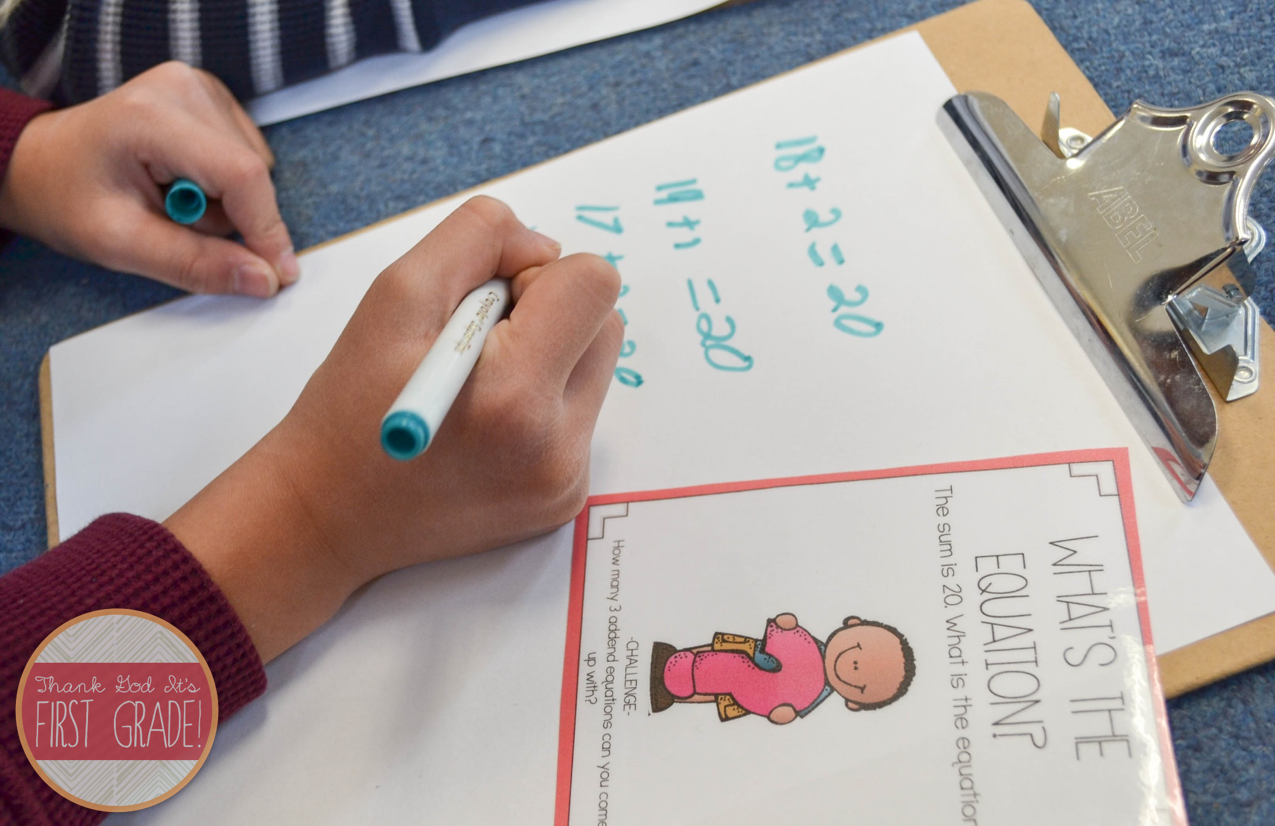I also had to incorporate “math talks” in my classroom as often as I could. These talks
got my students discussing their solutions to problems, defending their
answers, and providing different ways to solve any given problem. They got my
students THINKING!
Over the years I created and collected tasks that are both challenging and fun for my first graders. Each task also has a challenge question
that can be used when a student solves the problem and is looking to challenge
themselves a little further.
Here are some in use in my classroom:
What's the equation: The sum is 20, what is the equation?
These two students worked together to come up with many different ways to make 20, including 3 and 4 addend equations.
Test time! To see if these two had progressed with subtraction within 20, their task was to create a math test (with an answer key) to give to a friend! They loved getting to be the teacher and I could tell right away that they knew how to subtract within 20 easily!
Dress Teddy! This was a fun and tricky number sense problem for my students. They had to look at the clothes and try to figure out how many different outfits they could make for the teddy bear. At first, this group was all sorts of confused. Until one of my kids said, "let's start with the pants... there's only one pair of pants." From there they could mix and match and record the different outfits. It is SO hard to bite my tongue and not guide them, but if you can hold back long enough it is amazing to see them persevere to get the answers. They feed off one another and it is pretty cool to watch!
I created 8 different tasks (which each have an additional *challenge* task) for each of the following domains:
Number sense
Addition
Subtraction
Place Value
Geometry & Measurement
Time & Money
Each task comes in 3 different forms as well. There is a printable version that you can see above with the question on it. There is a guided printable version which is the same, but has guiding questions to help your students complete the problem, and a task card version to print, laminate and pass out to groups.
Here are some in use in my classroom:
Counter sums: Students try to use the counters to make a sum of 12 in many different ways. For this particular student, I had them draw dots on counters to manipulate and make more equations!
What's the equation: The sum is 20, what is the equation?
These two students worked together to come up with many different ways to make 20, including 3 and 4 addend equations.
Test time! To see if these two had progressed with subtraction within 20, their task was to create a math test (with an answer key) to give to a friend! They loved getting to be the teacher and I could tell right away that they knew how to subtract within 20 easily!
Dress Teddy! This was a fun and tricky number sense problem for my students. They had to look at the clothes and try to figure out how many different outfits they could make for the teddy bear. At first, this group was all sorts of confused. Until one of my kids said, "let's start with the pants... there's only one pair of pants." From there they could mix and match and record the different outfits. It is SO hard to bite my tongue and not guide them, but if you can hold back long enough it is amazing to see them persevere to get the answers. They feed off one another and it is pretty cool to watch!
I created 8 different tasks (which each have an additional *challenge* task) for each of the following domains:
Number sense
Addition
Subtraction
Place Value
Geometry & Measurement
Time & Money
Each task comes in 3 different forms as well. There is a printable version that you can see above with the question on it. There is a guided printable version which is the same, but has guiding questions to help your students complete the problem, and a task card version to print, laminate and pass out to groups.
I
use all three versions of the tasks in my room. We use the task cards in groups
with large posters for students to show their work. When we split up into
groups like this, I choose tasks that are appropriate for each group based on
their needs. I also make sure to put aside time for the groups to explain their
work and their answers.
In
small groups, I will often use the printable versions (guided or not based on
their ability levels) so I can observe their thinking and guide them as
necessary through the problem solving process.
However
I choose to use the tasks,
I make sure that talking is a HUGE
part of the task. I often ask questions that start with these stems:
-Why
did you ______________________?
-What
if you __________________________________?
-Is
there another way you could’ve ___________________________?
-How
do you know _______________________________?
I
love to see the discussions that occur when my students walk me through their
process. They show their peers new ways of thinking that help them in later
tasks. They also impress me over and over again!
If you think these would be great for you students, head on over and check them out:
You can download the preview for more examples of the tasks :)
Pin it:
If you think these would be great for you students, head on over and check them out:
Pin it:










